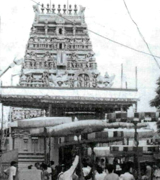Main Feature
The Bhavani Duo

They did not hail from a place rich in fertility of land or mind like Tanjavur; they were not cradled in a lineage, hoary with traditions of music running through many generations; and, until they began studying music as a regular discipline, they had not even imagined that they would enter a vocation as beckoning and as bewildering as music. In a more literal way and in a far truer sense than in the case of many others, it can be said that they did not choose music as their goal in life,- it is music which chose them as its votaries. And they did not belie its choice.
The B.V. Brothers, Raman and Lakshmanan, belonged to a Brahmin family from Bhavani near Erode, which might have seen better days, but not certainly very affluent at the time the brothers were born as twins in February 1921, at Gooty in the present Andhra Pradesh. Their father, B.V. Subrahmania Iyer, was stationed at Gooty as Deputy Collector, at the time of their birth.
Heritage
Madhava Perumal Temple, Mylapore

Mylapore is well known for two Vaishnavite temples. The larger one is the Kesava Perumal temple located near Chitra Kulam. The smaller one, Madhava Perumal temple, is on the northern side of Mylapore, close to the famed Mundakanni Amman temple. (The correct name is Mundaka kanni— lotus eyed, but over the years has become Mundakanni by usage).
Approach to the shrine
There are two ways to access the shrine. The first is through Mundakanni Amman Koil Street, which is a cutting off Kutchery Road. It is best to navigate this street by walk as it is exceedingly narrow. The other option, for those wanting to travel by car is to come in through Arundel Street, which is a cutting further down Kutchery Road, closer to Santhome. Arundel Street after a few twists and turns leads to Madhava Perumal Koil Street.
A Series For The Younger Generation

The Dept. of Posts issued a stamp on Samarth Ramdas— this is the spelling used by the Department—on 1 May 1988. It is in the denomination of 60 P, perf. 13, and is in olive green colour. It is printed on indigenous un-watermarked PG Matt coated stamp paper by photogravure process in the India Security Press. Both the stamp and the First Day Cover depict Ramdas.
Life of Ramdas
Samartha Ramdas was born as the second son of Suiyajipant and Ranubai in Jamb, a small village in the Marathwada region of Maharashtra, on Ramanavami day in 1608 AD. He was named Na ray a n; he was to be known as Ramdas only after three decades. He had an elder brother named Gangadhar.


